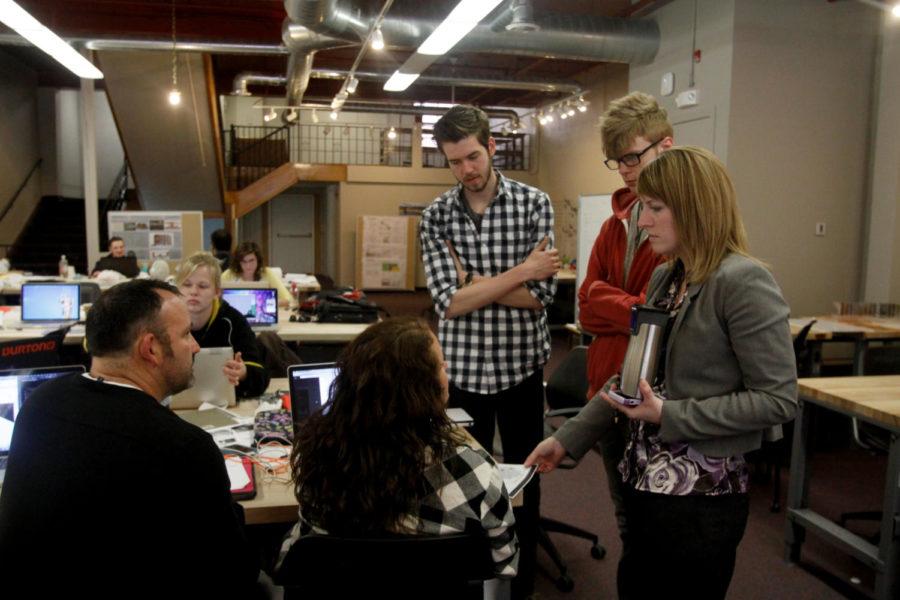Big designs for small towns: ISU design students, retail initiative aim to improve Iowa life
April 18, 2014
Design on Main comes alive at 1:15 p.m. every Monday, Wednesday and Friday as College of Design students begin to arrive at the studio. Surrounded by detailed sketches of pubs, restaurants, coffee shops, bike trails and breweries, students develop their ideas of how to improve life in rural southwest Iowa.
These ideas are part of a multi-faceted effort from the Iowa Retail Initiative, which includes another project focused on branding and business strategy in Story County. The course doing this portion of Iowa Retail Initiative outreach, Design 546, is a senior-level studio option for design students.
The initiative began in spring 2013 and works with a $250,000 grant from the Iowa State’ Extension and Outreach Strategic Initiative. Some of this money has been allocated to the professors working on this design project.
“We were interested in pulling together resources from across the university to assist local retailers across Iowa,” said Mary Erickson, Iowa Retail Initiative program co-director and program coordinator in the Institute for Design Research & Outreach.
Tom Neppl, lecturer landscape architecture and Iowa Retail Initiative project co-director, said that the project leaders collaborated with the College of Design and Communities Extension to define a geographical region with a demonstrated need that would benefit from working with this course. They wanted a community whose members would engage in the process.
The region chosen was southwest Iowa. Students are working closely with the communities of Red Oak, Clarinda and Shenandoah in an attempt to create a regional identity that would promote success in the area.
Lisa Bates, lecturer of interior design and Iowa Retail Initiative project director, said that southwest Iowa faces issues that are common to small communities in Iowa, such as empty storefronts and a struggle to bring in young people, professionals and new businesses.
Erickson said that in the past 40 years, there has been an emptying out of small-town retailers and that it has harmful effects on the communities.
She also said that designers are able to look at these types of social problems with a holistic approach.
Students are focusing on coming up with improvements for these communities, but their impact will not stop there.
The goal is to broaden the impact of this project by finding design principles that can be enacted in other locations and creating a toolbox of ideas to make available to other communities, Erickson said.
“We’re not just helping three communities. We are looking for ways that this can be of use across the state,” she said.
Neppl said that this project is unique in that while students may have worked on real project sites, for many of them, this is the first time working with real clients in a real community.
“This is giving a little sampling of what’s to come,” he said.
Neppl also said that students are responding well to this collaboration and have been engaging with the communities. Students have had three community presentations and site visits thus far and will present their ideas to the communities in an open forum April 28.
Bates said that the communities have enjoyed receiving advice with a younger perspective.
None of the students were previously familiar with the region.
“Having them see everything with new, fresh eyes is a new perspective than the community members that live there on a daily basis and see everything over and over again,” Bates said.
Mollie Bourke, senior in architecture, is working on an outdoor recreation system proposal. She said that through this project, she has learned to continually communicate with a client, take his or her thoughts into consideration and eventually sell an idea to a client.
Bourke, along with most of the other students in this course, went on a field trip to the Pacific Northwest and Canada earlier in the semester. They experienced cities with distinct regional identities, including Seattle, Vancouver, British Columbia and Bellingham, Wash.
Going on this trip helped fuel a discussion of what regional identities would be effective for this project, Neppl said.
In the future, members of the initiative would like to expand their outreach to include local grocers.
Erickson said that they are grateful for funding from the extension offices and for the opportunity to work on something they all believe in: small scale, local retail.
“It’s not retail alone that we ended up looking at,” Bates said. “It’s overall quality of life.”







